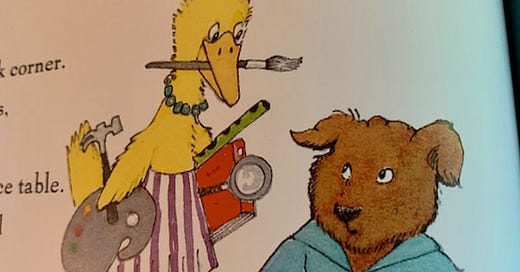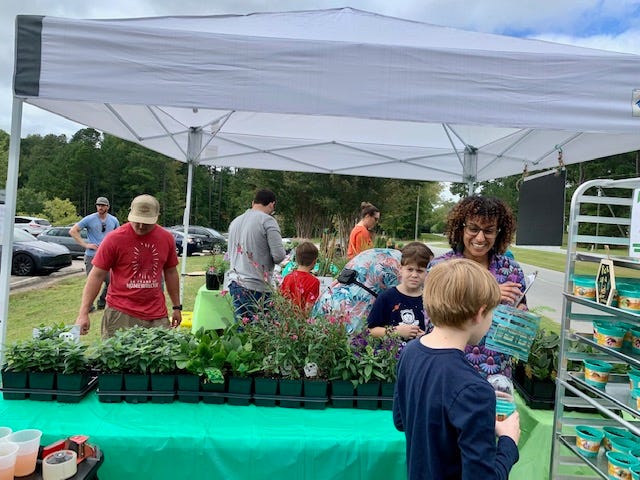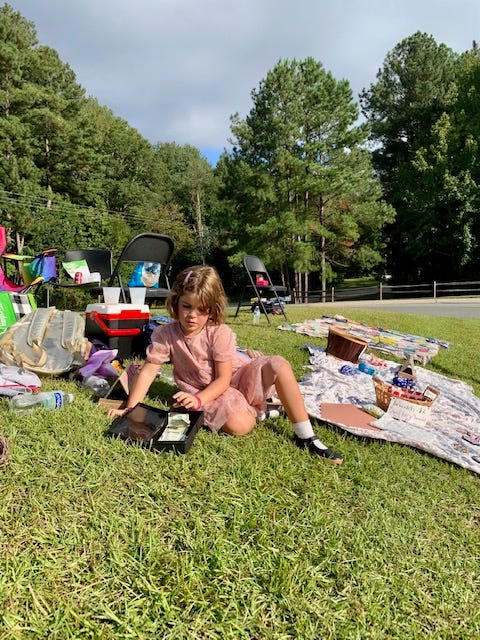One of my favorite, most useful expressions lately comes from My Kindergarten, that wise, school-through-the-year picture book by Rosemary Wells. When Diane Duck notes that Roger, who spends every choice time in the car-and-truck corner making gearshift noises and saying words like “generator,” isn’t widening his horizons, Miss Cribbage says, “It takes all kinds to make a world.”
I bust this expression out all the time—when Bea tells me a quarter of her class came as Youtube Stars for career day, when the Tesla driver playing computer solitaire in the car line says “not today, thanks” after we ask if she wants to buy a socktopus or bracelet for the school fundraiser. Bea totally gets it, and Harriet does too— a kind of if you can’t say something nice…
But Ms. Cribbage doesn’t mean it like that—it’s not the Cranberry Island version of “Bless his heart.” I think she actually means hey, maybe Harry will fix your car one day and you’ll be grateful. And, our classroom is a more interesting place because Harry is here, making his gearshift sounds in the car-and-truck corner.
Maybe it’s easier to remember this use of the phrase when we apply it to all the wonderful things we see. For example, all the generous FTT subscribers who have given to our school fundraiser. Or, the native plant and crafts sale our school held on Friday, which raised more than $1200 for garden boxes and playground equipment, and which provided many free plants for our soon-to-be-planted gardens.
Bea sold socktopuses and Swiftery bracelet kits (each bracelet spelled the name of a different album, which you only see when you open the bag), and Harriet sold “sparkle phones and tablets” (cardboard phones with sparkly buttons and aluminum foil screens). Their friend Arley sold stuffie sleeping bags and pillows (we bought a set), and Pepper and Betty sold stretchy bracelets (we got some of these too). Betty and Brittany brought delicious lemonade. Many kids brought books to sell, and some kids were just there to help spread the word and entice customers. Deena and Amelia brought dozens and dozens of gorgeous native perennials—joe-pye weed, goldenrod, cardinal flower, black-eyed susans, ferns, columbine, and many more. Most are deer-resistant, so with Deena’s help we chose the best ones for our steep, shady yard, and will work on planting them today.
Fall is the best time for planting perennials, because the summer-warmed soil, rains, and shorter days help plants spend their energy on root production. Stronger roots mean that by spring, they’ll be ready to grow and flower.
And native plants are the best for landscaping because…
They’re made for the kind of soil and weather you have in your area.
They’re beautiful, many with delicate flowers and hearty greenery you can enjoy for much (or all) of the year.
They are also great for the whole ecosystem where you live, and provide food and shelter to many animals, including insects and mammals.
Turtles and frogs need native plants too! They offer shelter and attract species that frogs and turtles need for food.
They’re necessary for pollinators including hummingbirds, native bees, butterflies, moths, and bats. These animals, in turn, are necessary for food production for us.
They conserve water and are easier to take care of than non-native plants. Most are low-maintenance and don’t require as much watering as, say, a lawn.
They help combat climate change by removing carbon dioxide from the air, releasing oxygen, and storing carbon.
If you want to search native plants in your area, you can search by your zip code with the National Wildlife Federation or the Audubon Society.
And, our friend and neighbor Ellen tells us, now is the perfect time to cut back (or pull) any invasive stilt grass you see. Here’s Ellen’s advice:
Our roadside ditches and woods are loaded with invasive Japanese Stilt Grass (microstegium vimenium). Per NC State Extension, mowing in late summer, before flowering and seed set (mid-September through October) is most effective.
I planned to include the image of Buddy, doing his bit to manage Stilt Grass, as a lighthearted encouragement, but, when cropping the photo, I noted with dismay a flowering spikelet (by Buddy’s cheek). The picture was taken September 13, a week and a half ago. Ideally, we’d have launched an attack late August/early September. But I think it’s still worth doing. Not all the grasses are flowering yet.
Here are the stats:
*Stilt Grass is an annual. It does not come back from roots each year. It spreads through a high production of seeds. It can produce large numbers of seeds – from 16,000 to 50,000 seeds per square meter.
*Every square meter you knock down prevents thousands of seeds being deposited in the existing seed bank.
*Doing this every year will keep Stilt Grass to a minimum and allow the plants, shrubs and trees which contribute to our environment to re-establish themselves.
String trimmers locked and loaded? Let’s do it!
Last night, Richard and I happened upon Ellen and Buddy on our evening walk—Buddy was munching the stilt grass along the path to the river, and Ellen was pulling it by the roots. It was nearly dark, but they were working away, leaving a wide, cleared space where native plants can thrive.
Takes all kinds to make a world!
Neighbors like Ellen, Deena, Brittany, Donna, Julie, and many more are why I love where I live and can’t stand the thought of leaving it. I met Ellen because she lives around the corner, and the others through our public school PTA. You don’t have to be a parent of young kids to meet great neighbors, or to invest in fighting against some of the harmful policies and laws passed by North Carolina’s majority-Republican state legislature, like the new voucher law that will drain millions of dollars from public schools, or the brutal, anti-LGBTQ “Parent’s Bill of Rights.” Both passed this summer and fall. Both will make it harder for schools and kids to get what they need, and to feel safe. They are the unmaking of the world of shared public goods that we know and depend on.
If you live in North Carolina and want to help fight against these laws and their impact—or do and support good work in your community, I strongly recommend joining Public School Strong, HEAL Together, and/or Down Home.
All three multiracial, multigenerational, grassroots groups embody Miss Cribbage’s expression, in the best way.
*
In other news, Bea and I were in Publishers Weekly’s Children’s Bookshelf newsletter this week:
Hannah Fries at Storey Publishing has bought world rights to mother-daughter team Belle Boggs and Beatrice Boggs Allen's Plant Pets, the first houseplants book written specially for kids. The book profiles the authors' favorite easy-to-care-for plants, including aloe, air plants, moss terrariums, and Venus flytraps. Publication is planned for summer 2024. Kate Johnson at Wolf Literary Services represented the authors.
We’ve done the first round of edits to the illustrated pages, and oh wow, it is looking so great! Would y’all like to see a sneak peek of the cover soon? Any favorite native plants for fall?








i love the heart and soul of Frog Trouble Times with all my heart and soul !
Congratulations on the houseplant book! I can't wait to order one or two or three!! (Also, I worked diligently over several years trying to keep Stilt Grass out of my backyard. It spread up from the little creek at the bottom of our lot. I can't even imagine the spread now that I haven't lived there for 4 years. (I now fight with bamboo, and it is winning, sad to say.)